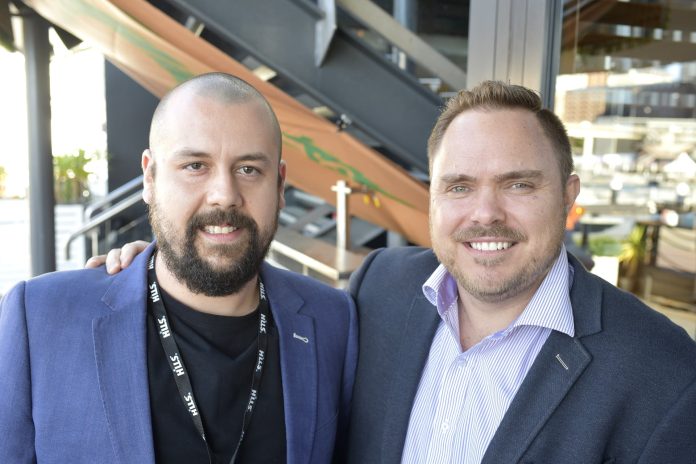SEN editor John Adams speaks with SCSI’s Dale Acott and Chad Wright about the future of alarm monitoring, automation and IoT, the company’s new lifestyle technology play, and the end of the alarm panel as we know it.
JA: Before we talk about SCSI’s ground-breaking new solution, let’s talk about telecommunications for a moment. What’s your take on NBN? It’s a facilitator of change – no doubt – but is NBN as we know it good enough to be the roadway of the IoT future?
DA: Fixed line services in Australia are generally of poor quality – let’s be honest, the NBN is not a great service – in some cases it’s no better than customers were getting with ADSL. If you compare that to a 4G SIM card which is pulling 80-90Mb with no interruption and no contention, the answer to that question is clear. That’s why we have always have a private wireless network to support our customers – high security, high uptime, no contention.
JA: SCSI is a wireless specialist – given this expertise, could you explain to readers what 5G is?
CW: 5G is an unknown at present from the point of view of underlying technology because 5G is an operational specification – a benchmark. Because the providers are unlocking capacity from multiple layers of wireless technology as we speak, it’s very hard to establish exactly what is possible. Obviously, it’s going to be better than anything the market has seen before where it’s possible to provide it. And that’s where the impact of new technology, of automation on IP networks comes into the equation. These new technologies allow monitoring stations to give customers a level of functionality they will be prepared to pay for because they will see a clear ROI – enhancements to security, enhancements to safety, improvements in efficiency.
JA: From the point of view of SCSI what is the future of your business, is it an Australia-centric business model or do you have your sights set further afield?
CW: We will always do business in Australia but it’s a connected world and we have solutions that meet the demands of a connected world so we are planning to expand OS.
DA: The broader business relationship is that SCSI has its sights set on America. We partner with Bold Technologies – we have 5 Bold monitoring stations with more on the way. Bold is a partner with more than 600 central stations and 12 million lines. We want to work more closely with Bold by integrating our products with their technology. The monitoring business is about more than today, it’s about what you can sell and support into the future – about how you can meet customer’s developing needs. We’ve spent a lot of money over the past 18 months on product development in the professional space with our 4G DTU – we are looking at providing additional services with that.
The track we are planning to go down involves bringing the alarm panel and the monitoring station into a smart world and doing it in a way nobody else is doing it. I see the solid-state alarm panel as going extinct. In the future, the controller will be built into a customer’s router. Every household has a wireless router and sensors and other devices will report events via the router in flexible ways allowing expanded functionality and multiple new business models.
JA: And SCSI is going to get involved in providing that smart router solution?
CW: We are partnering with a new company on a third gen product. It’s not just a router – this product offers everything a customer might want to manage any aspect of technology that is important in their life. The system supports NBN, Wi-Fi mesh, has professional security monitoring built in, has IoT security built-in, it has ZigBee, professional Wi-Fi sensors, 8-hour battery backup, as well as being the first touch screen router ever made and the first product to have Amazon Tech? integration.
It delivers everything any user and any installer or monitoring provider needs. It can be installed DIY, or be professionally monitored, or users can make use of monitoring on demand. You can control any device from its app – view cameras, answer intercoms. You can even manage the smart devices that are accessing the internet via your router. But more than that, it’s about making all this functionality as simple as possible.
And it helps customers manage all aspects of their lives. It can control automation, lights, anything you can think of – voice activation, IoT, set up rules – when you arrive home, the lights turn on, air conditioning activates – it’s more than that. Everything can be done from the touchscreen or via the app – you don’t need to pull out a laptop to program it. There’s a basic DIY-style version and a version that is driven by us. So, it’s a hybrid solution in one sense.
JA: Will the solution be device-agnostic? For instance, will it support all Z-Wave devices?
CW: To all intents and purposes, it will be device-agnostic. Right now, the number of products it already works with is huge – all the Z-Wave and ZigBee products, for instance. You can also integrate an existing wired system into the system. Z-Wave security products now have a security standard that they must meet making them far more secure than traditional security devices. We can also put in a Bluetooth module if that becomes more prevalent in the future.
JA: This product competes with traditional intrusion manufacturers?
DA: Yes, it does. Traditional intrusion manufacturers are falling behind. As a telecommunications company, we’ve spent the last 20 years and a lot of money building wireless modules in parallel with traditional manufacturers that will allow various solid-state alarm panels to handshake with advanced communications technologies. We don’t need to do that any longer. The $89 wireless DTU we sell that is installed alongside alarm panels in the field doesn’t need an alarm panel, there are that many inputs and outputs. It could do the job by itself.
What came first with this product is the coolness of an holistic management solution – not security, but the ability to manage everything – not only subsystems connected to the network, but the network itself. To monitor devices accessing the internet via the network, to manage monitoring in real time – to have an alarm event monitored when you need it not when you don’t, to have it monitoring based on event, or time of day, or when you are on holiday. It’s not about the alarm, not just about arming and disarming the system, it’s about managing your life.

The cyber security/IoT security aspect of the solution is a key part, too. It’s built-in to the router as a subscription package and you select the security level you want the solution to have using a check box. The system, with everything built-in including cellular data, IoT and professional monitoring is 24.99 per month. It does not matter where you are – if an alarm event takes place, it notifies you on your phone and you can disregard the message, respond yourself, or push the message to the control room to be actioned – you are in control of monitoring on an event by event basis – whether or not you want the control room to action a particular alarm on a particular day.
JA: If SCSI also sells the service, who will the monitoring of those customers be handled by?
CW: That will go through to our contracted national monitoring provider. Something to bear in mind is that this is not a security product – it’s a 4G data service – we provide the router, backup battery and sensors.
JA: How many monitoring station partners does SCSI have in Australia which have an opportunity to come onboard with the new solution?
DA: We have 40 control room partners in Australia and we have been telling them about this development in stages for some time – we showed an early version of the product last year and at Security 2017 we told our partners everything there was to know about it. All our control room partners now have the change to get involved.
JA: What is the business model – is it Alarm.com, is it MONI? What is the business of SCSI?
CW: In terms of the business model we are offering our monitoring station partners an opportunity to come on board with the solution but we also (and this is where people may struggle with it) will be promoting it ourselves. We have a marketing package that we have invested in and we will promote the product and sell the product. At the same time, our partners can promote and sell the product, they can own the covers (branding?), they can provide additional services, they can choose the different rates they charge – they can create whatever business model they like with it.
JA: Is this a change of direction for SCSI?
CW: Not fundamentally. People see us as a security company but we are a telecommunications company and that’s something our partners can leverage – they can offer customers not just security and automation services, but data services for Internet as well. We are putting a solution of great power into the hands of consumers but we are also putting a solution of great power into the hands of our monitoring partners, who can select the types of services they want to offer their own customers.

At the retail level, we have our prices but partners can price services as they see fit based on the services they choose to provide. They might offer data, IoT and security – when users are selecting a level of service those fees will show up in the app. If an installer is setting up a system for a customer they use the app to select a plan – and that will include monitoring and alarm response, all on the app.
JA: What has the response from the market been?
DA: Some people have been challenged by this business model. For some monitoring stations, it’s all about a guaranteed return based on line numbers – but the future is not going to be guaranteed – not in the old way. The future is going to be different and not everyone is going to like it. Considered in this light, some will see SCSI’s new system as a great solution and others will want to stick with what they know – they may find IP-based solutions like this threatening.
JA: From what you are saying this is lateral and vertical solution – there are certainly app-based solutions out there but nothing that is quite as connected to the business stack as this seems to be. You’re not just giving users multiple layers of service, you’re giving installers multiple layers of system, monitoring stations multiple layers of solution. And SCSI is getting something, too. It’s a complete re-thinking of the business model from data all the way through to IoT. I would expect something like this to come from Telstra, not SCSI – so you’re right – people do see SCSI as a security company, not a telco. You obviously see real opportunity?
CW: We see a massive opportunity – we see Australia as being at the entry to automation but no one doing anything to drive it. For us this is not just about having a quality product and a good service but we think someone has to drive the business forward. The security industry on its own is not going to drive this product so we have to put our money where our mouth is and promote it – we must put our solution up there in shining lights so people want it and whether they buy it from us or from our partners, we don’t mind.
DA: It’s a real market disruptor – we want all our partners to be on board with it – it’s what’s needed for a future where people can stream any movie they like for 12 dollars a month. We are bringing that future to the market through the security industry, as well as through the wider retail market. We will have retail partners (who will offer monitoring services through our partner monitoring stations).
JA: Fundamentally, what this gives installers and monitoring stations – with provision of data services, on-demand monitoring for clients who might never use professional monitoring and IoT services, is new revenue streams to replace rebates?
DA: Yes, that’s exactly what it means – the monitoring station will get new revenue streams to replace rebates. Rebates in this country – the payment of a percentage by a telco to a monitoring provider for every call an alarm panel makes – is a real problem. SCSI has been the biggest provider of rebates to the monitoring marketplace but at this critical junction, I can’t see the back of rebates fast enough. Rebates are still locking businesses to old technology and have seen the price of professional monitoring actually go down over a 20-year period. The NBN will have the impact of ending rebates – that’s one thing the NBN will do.
JA: Is the Australian market ready for a solution like this?
CW: It’s a consumer-based market now and we really see the wider market as being at the cusp of a major change – users don’t want to be locked into a product in the traditional way – they want something more – they want a simple product that does everything they want it to do while offering deeper functionalities. In the US, the cut-off of old technologies and ways of operating has been much sharper – that’s down to rebates here – they have more home automation. But we are going to another level, it’s an entire communication system – it’s everything the user could want in terms of comms, security, automation – management of internet traffic and smart devices – it’s everything. You can have multiple versions across multiple sites in one business.
JA: Will some monitoring stations see you as being in competition with them?
DA: For some that will be the first thought but we are absolutely not going to be in competition with them – we will still be partnering with monitoring stations as before. We are not a monitoring company and have no desire to be a monitoring company. But we do want to drive the vertical and to be intrinsic to the vertical. Simply, the market is going to go there – to automation, to IoT – and we are going to take the market there – we are going to go further than the market ever has and we are going to take our partners along for the ride.
It’s an end-user driven world now and we all need to meet it. We must meet the demand of the market for an improved service, a service that offers more for a customer’s investment and a service that has new sales hooks and that is functionally simpler. I think most our partners will come with us – some may not – but rebates – that revenue has diminished by 40 per cent in the last couple of years and it simply can’t go on. The old monitoring model has been broken for a while and with this new solution, monitoring stations can get in on a much bigger solution with a much larger potential client-base at any level they choose. ♦













